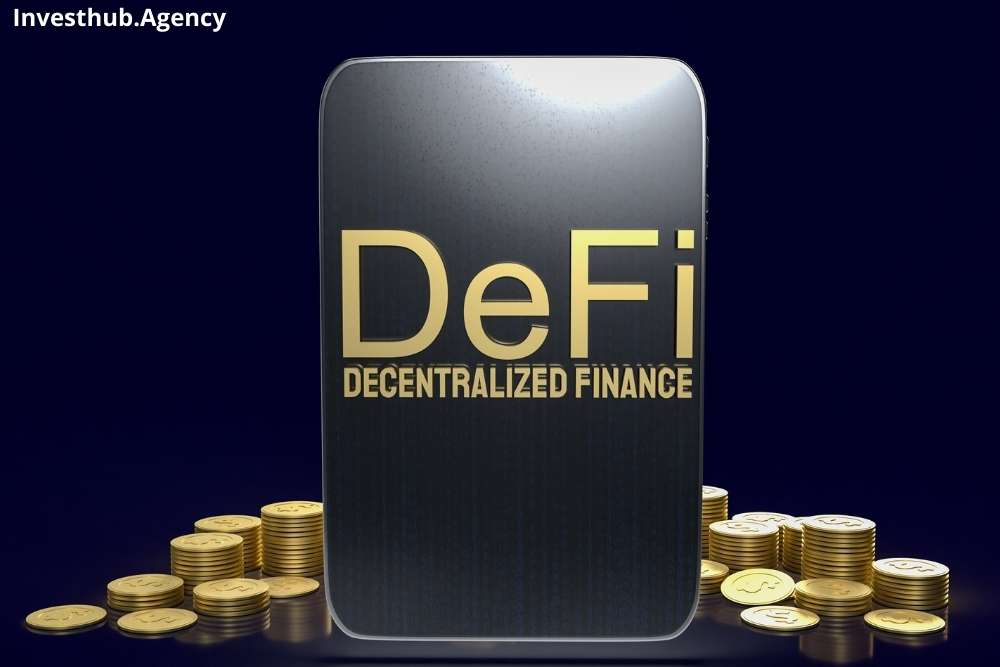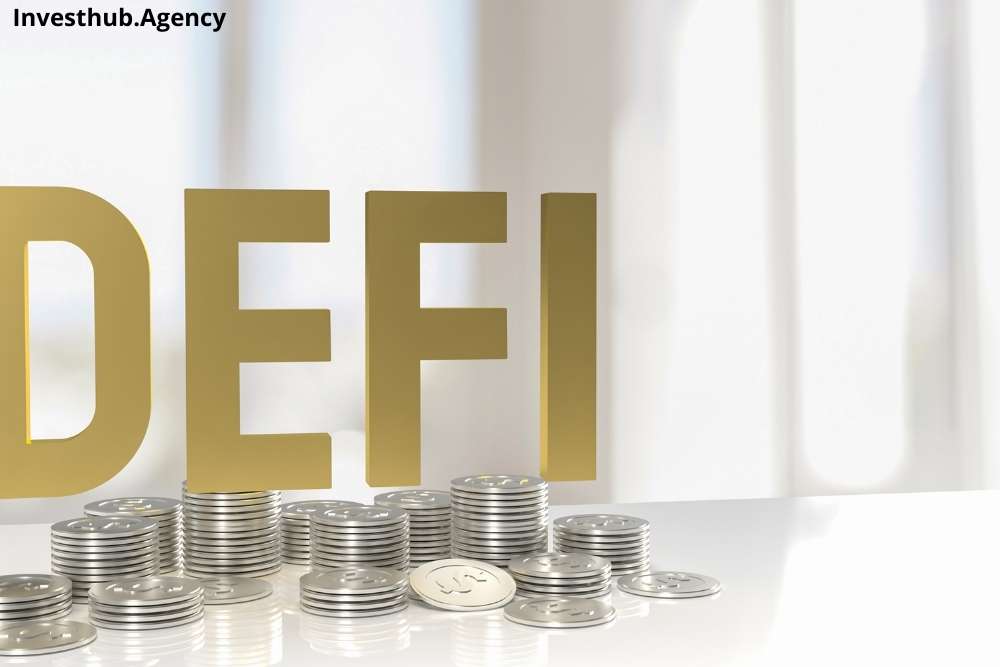Decentralized Finance (DeFi) refers to carrying out financial services on a public blockchain.
In simple words, it refers to financial services that are not governed by any central body or banks.
Overall, it can be called a fusion of traditional banking services with blockchain technology.
The technology removes intermediaries by allowing consumers, merchants, and corporations to perform financial transactions using developing technologies.
The system uses peer-to-peer financial networks that use security protocols, connectivity, software, and hardware developments.
You may lend, trade, and borrow using software that records and validates financial transactions in distributed financial databases from anywhere with just an internet connection.
A distributed database is accessible from several places; it collects and aggregates data from all users and verifies it with the help of a consensus process.
Decentralized Finance uses this technology to abolish centralized finance models by allowing anybody to access financial services.
In this article, we will cover all the topics related to:
- What is DeFi?
- How Does DeFi Work?
- Types of DeFi Applications
- The Future of Decentralized Finance
What is DeFi?
DeFi is a leading digital infrastructure that uses blockchain technology and eliminates the need of central or governed bodies to approve financial transactions.
The Ethereum network serves as a foundation for other blockchain apps to be developed on it.
Two or more parties can swap, borrow, lend, and trade directly using blockchain technology and smart contracts using dApps without the participation or fees of a middleman.
The network is linked to the blockchain, the decentralized and immutable public ledger that underpins Bitcoin and allows all computers (or nodes) in a network to keep a copy of the transaction history.
This means that no one has control over or can change the transaction ledger. In simple terms, it’s a fair, free, and open digital marketplace.
How Does DeFi Work?
DeFi provides financial services using blockchain networks and smart contracts, eliminating the need for intermediaries such as guarantors.
The services available on the network include:
- Lending (where users can lend their cryptocurrency and earn interest in minutes).
- Receiving a loan instantly.
- Making peer-to-peer trades without a broker.
- Buying derivatives such as stock.
Users use dApps, which are mostly available on the Ethereum network, to allow peer-to-peer commercial transactions.
Altcoins, stablecoins, tokens, digital wallets, mining, yield farming, staking, trading, borrowing, lending, and saving using smart contracts are among the more widely used services and dApps.
Decentralized Finance is open source, which means that its protocols and apps are theoretically available for users to examine and improve.
As a result, users may create their own dApps by combining protocols to uncover unique combinations of opportunities.
The popular features of Decentralized Finance are sending money anywhere in the world, storing money in crypto wallets; borrowing and lending on a peer-to-peer basis; trading cryptocurrencies anonymously and at any time 24/7.
The other features include trading tokenized versions of investments such as stocks, funds, other financial assets, non-fungible tokens (NFTs), and buying insurance.
Types of DeFi Applications:
There are several types of Decentralized Finance applications available, major of which we have listed below.
Decentralized Exchanges (DEX):
Users can trade currencies for cryptos or other currencies through online exchanges. DEXs are a popular sort of Decentralized Finance that links users directly so they can trade cryptocurrencies without entrusting their funds to an intermediary.
DEXs let users purchase and trade cryptocurrencies directly with one another in a trustless environment.
As with centralized exchanges, assets exchanged on DEXs are never kept in a third-party wallet.
Prediction Markets:
In Prediction markets, users bet on the result of an upcoming event such as the presidential elections in the US.
Participants’ primary purpose is profit, while prediction markets can occasionally outperform traditional approaches such as polls in predicting events.
Prediction markets are typically frowned upon by governments and frequently shut down when administered in a centralized manner.
In addition, DeFi has the potential to increase interest in prediction markets.
Lending Platforms:
Lending platforms are one of the prominent types of Decentralized Finance that links borrowers with cryptocurrency lenders.
Users may borrow or lend their cryptocurrencies using the lending platforms. Users lend out their money and earn interest.
Decentralized Finance lending is collateral-based, which means that in order to get a loan, a user must put up collateral, which is frequently ether, the Ethereum token.
That means customers don’t have to reveal their name or credit score in order to get a loan, which is how traditional, non-Decentralized Finance loans work.
Stablecoins:
Cryptocurrencies have more volatile prices than fiat currencies, which isn’t ideal for those who want to buy it for a shorter time.
Stablecoins are cryptocurrencies that peg their market value to a fiat currency such as the US dollar in order to maintain the price stable. As per its name, Stablecoins attempt to create price “stability.”
Yield Farming:
For seasoned traders prepared to take a chance, yield farming is a method of sifting through numerous DeFi tokens, searching for higher-returning prospects.
Composability:
dApps are open source, which means that anybody may look at the code underlying them. So, using the code as building blocks, these applications can be used to “assemble” new apps.
Money Legos:
DeFi applications are similar to Legos, the toy bricks that children click together to build buildings, automobiles, and other structures.
DApps can be snapped together like “money legos” to create new financial solutions.
Derivatives:
You don’t always want to be restricted to exchanging certain coins or tokens. People can do more than spot trading with derivatives platforms.
For instance, Users can leverage their transactions by betting more than they have or create “synthetic assets” that mirror traditional equities and commodities.
How to Make Money in DeFi?
If you’re wondering how to make money in DeFi, here’s a complete guide to make you understand better.
There are many ways to make money, and one of the most common ways is using Ethereum-based lending apps to generate passive revenue.
Users essentially lend their money out and earn interest on the loans. On the other hand, Yield farming is another approach, which is a riskier activity performed by more skilled traders.
In this, users search through a plethora of Decentralized Finance tokens in the hopes of discovering prospects for higher returns, but it isn’t easy and offers zero transparency.
What are the Risks associated with DeFi?
Decentralized Finance, like many other new decentralized blockchain networks, is extremely risky. There are several risk factors associated with Decentralized Finance.
Here are 5 Risks associated with the Decentralized Finance network:
Risk of Intrinsic Protocol:
Decentralized Finance networks use smart contracts to automate particular financial primitives. One of the most critical risk elements in dApps is the dynamism of such protocols.
Intrinsic protocol risk refers to risk mechanisms that are built into a protocol’s infrastructure by default.
Even if the processes are performing as planned, they nonetheless pose significant risks to investing plans.
Risk of Exogenous Protocol:
DeFi trades are frequently exposed to exogenous variables that affect the protocol’s intended behavior.
While intrinsic protocols are based on native dynamics, Decentralized Finance transactions are frequently subjected to exogenous circumstances that alter the protocol’s expected behavior.
Oracle manipulations, flash loan exploits, and attacks that take advantage of defects in the smart contract logic are all types of exploits that target the underlying mechanics of a protocol.
Governance Risks:
Decentralized governance proposals control the Decentralized Finance protocol’s behavior and are the source of changes in its liquidity composition, impacting investors.
For instance, changing the weights in AMM pools or the collateralization ratios in lending protocols can aid liquidity flow in and out of the protocol.
The rising centralization of the governance structure of various DeFi protocols is a more problematic feature of governance from a risk standpoint.
Risks of Underlying Blockchain:
DeFi protocols rely on their underlying blockchain infrastructure. Therefore, compromises in components such as a blockchain’s consensus procedures might manifest as vulnerabilities in protocols running on that platform.
For instance, a group of validators may conspire to affect the network’s reward distribution and effectively ban Decentralized Finance protocols from working.
Market Risks:
We may think only about protocol and infrastructure and often overlook the inherent market risk exposure of investments in the field.
Investing in non-stablecoin AMM pools might result in a loss if the asset price diverges significantly from the moment the liquidity is delivered to the pool.
Another example is sudden drops in the price of an asset, which might result in a big withdrawal of liquidity from a pool, producing significant slippage.
The Future of Decentralized Finance:
The evolution of Decentralized Finance is still in its early phases, which means that infrastructure failures, hacks, and frauds continue to be the major problems of the ecosystem.
The laws have been passed on the concept of distinct financial jurisdictions, each with its own set of laws and regulations.
The potential of DeFi to conduct borderless transactions raises important problems for this form of regulation.
For instance, who will be responsible for investigating a financial crime that occurs across borders, protocols, and applications?
System stability, energy needs, carbon footprint, system updates, system maintenance, and hardware failures are among the other problems.
If the network succeeds in the future, banks and big businesses will almost certainly find a way to get into the system.
Until the end of 2020, Decentralized Finance products hold the market of less than $20 billion, most of which are on Ethereum.
The network valued at more than $260 billion in 2021. So if the current trend continues and the network maximalists are correct, we only see the start of a tremendous DeFi wave.
Experts say that the benefits of a decentralized and open financial system are simply too tempting to pass up the opportunity to capture billions of dollars in value.
Conclusion:
Overall, Decentralized Finance is a single term for a slew of new blockchain-based tools and services aimed at re-creating classic financial products in a decentralized manner.
It offers a collection of technologies that allow users to securely lend/borrow, exchange, and swap crypto assets without relying on third parties.
If you’re unsure about using DeFi platforms to trade cryptocurrencies, you can use the traditional centralized platforms.
The best thing behind using centralized platforms is that they abide by all the rules and regulations imposed by central or financial bodies.
If you’re searching for a centralized brokerage platform to start trading cryptocurrencies, there’s no better place to start than InvestBy.
The platform offers a range of tradable instruments, safety, and good customer support, making it a market maker.
FAQ:
What is DeFi?
Decentralized Finance is a new financial technology based on distributed ledgers that are similar to those used in cryptocurrencies.
The system uses blockchain to carry out financial services instead of banks and institutions.
Is DeFi a Good Investment?
The network users generally get substantially higher interest rates than those offered by traditional banking institutions. So, it can be a good investment option.
How to make money from DeFi?
Depositing your cryptocurrency onto a platform or protocol that will pay you an APY (annual percentage yield) for it is the easiest approach to making a passive income.
What are the risks associated with DeFi?
The major risks associated with using the network include scams, exploits, and fatal errors. However, with $92 billion in crypto assets now locked in peer-to-peer driven protocols, decentralized Finance is emerging as one of the leading segments of the crypto business.
Should I Invest in DeFi tokens?
It’s best to go with tokens that have a lot of liquidity. In general, the lower a token’s market capitalization is, the riskier it is to invest in it.
What is DeFi’s market capitalization?
The Decentralized Finance crypto market capitalization estimates at $114.10 billion.


